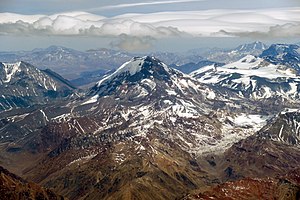Tupungato (volcano)
| Tupungato | ||
|---|---|---|
|
View from the north of the Tupungato Cathedral. To the right behind the active volcano Tupungatito . |
||
| height |
6635 m IGN Argentina, 6570 m (IGM Chile) |
|
| location | Mendoza , Argentina / Chile | |
| Mountains | To the | |
| Coordinates | 33 ° 21 ′ 31 ″ S , 69 ° 46 ′ 14 ″ W | |
|
|
||
| Type | Volcano dome | |
| rock | Andesite , basalt andesite and rhyolite | |
| Age of the rock |
Pliocene (3.6 to 5.3 million years ago) |
|
| First ascent | 1897 by Matthias Zurbriggen and Stuart Vines | |
|
The Tupungato towers over the neighboring mountains in such a way that it can be seen in Argentina from the plain in front of the Andes. |
||
The Tupungato is an extinct volcano over 6500 m high in the Andes , on the border between Argentina and Chile .
description
The Tupungato belongs to the mountain range of the Central Andes, which forms the watershed between the Atlantic and the Pacific, the highest mountains of which demarcate the border between Argentina and Chile. The summit height is given in Chile with 6570 m and in Argentina with 6635 m. It is the highest Andean mountain south of Aconcagua, 80 km away .
The Tupungato is essentially a volcanic dome that rises above a level of destruction. It consists mostly of Andesites and Basalt Andesites from the Pliocene (3.6 to 5.3 million years ago). At its top is a rhyolite dome that is about a million years old. It has no crater and is not a stratovolcano as early explorers assumed, in contrast to the active Tupungatito volcano on its southwestern side .
There are various theories about the origin of the name. It could come from Tupu-n-Catak from Quechua , which means something like "the top of the roof" or "the mountain top from up there". Or from Temmongacu from a local indigenous language, which means something like "viewpoint for stars" or "observatory".
Historical
On August 2, 1947, the Avro 691 Lancastrian of British South American Airways called "Star Dust" crashed on the Argentine side of the Tupungato and was lost for over 50 years (see Crash of the Star Dust ). Only on January 23, 2000, parts of the wreck were discovered by a group of mountaineers .
See also
Web links
Individual evidence
- ↑ a b c d e Volcán Tupungato. In: Andeshandbook. Sociedad Geográfica de Documentación Andina (SGDA), accessed December 27, 2019 (Spanish).
- ↑ a b c d e f González Díaz, Emilio F. Contribución al Conocimiento de la Petrografía del Cerro Tupungato (Provincia de Mendoza) y de otras Rocas Efusivas de la Región. Dirección Nacional de Geología y Minería, 1961. ( online in the Repositorium Servicio Geológico Minero Argentino (SEGEMAR))
- ↑ a b c Ramos, Víctor Alberto, et al. "Hoja Geológica 3369-III Cerro Tupungato." (2010). P. 85f ( pdf )
- ↑ Vicente Fidel Lopez. "Historia de la República Argentina, su origen, su revolución y su desarrollo político hasta 1852". Tomo 1. Buenos Aires 1883. ( online in Wikimedia)
- ^ Dionisio Chaca. "Breve historia de Mendoza". J. Castagnola, 1961


